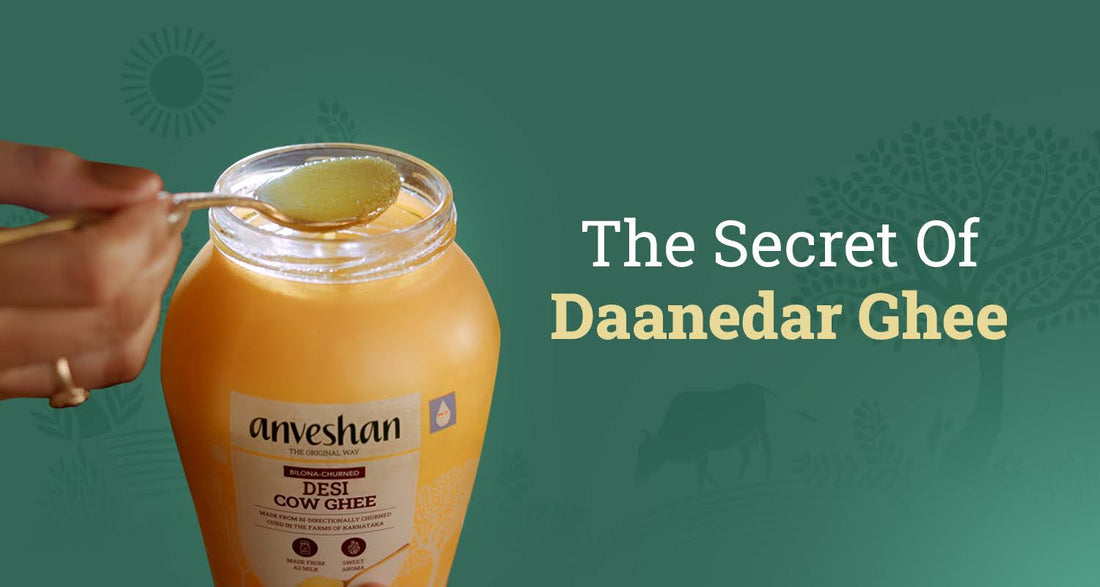
Why Anveshan A2 Desi Ghee Is Grainy – And Why That’s a Sign of Purity
Share
Kyun Hai Anveshan Ghee Daanedar? And Why Is It Better?
If you've ever opened a jar of Anveshan A2 Desi Cow Ghee and noticed its grainy texture, you might have wondered: Is this normal? Why does it look like this? Well, this danedaar texture is not only normal but also a sign of real, pure ghee.
This “daanedaar” or grainy texture of Anveshan Desi Cow Ghee is our pride and joy.
But why?
This texture is what ghee in India has always been known for, and it's one of the key indicators of quality. You might be new to real and pure ghee, but ask your mom or grandmother. Real ghee is rarely smooth.
The traditional, bilona churning method and patience are the reasons behind this texture. Let us bring you in on your secret!
The Science Behind the Daanedaar Texture: Why It Happens
You see, ghee granulation happens because of something called crystallisation.
It’s a natural process where the fatty acids in the ghee form tiny crystals as the ghee cools down.
The magic happens when the triglycerides (the good fats in ghee) crystallise at just the right temperature, forming these beautiful grains that we all love.
The Role of Temperature in Creating the Perfect Ghee
One of the key factors that affect ghee’s texture is the temperature at which it’s cooled.
-
If the ghee is cooled too quickly (think: fast-freezing), it won’t form the crystals correctly and will end up smooth.
-
The sweet spot for cooling is between 22-25°C (room temperature) for that perfect texture.
When Anveshan Ghee is made, it’s poured into jars while still liquid, and the jars are left to cool gradually at room temperature. This controlled cooling is what helps form the perfect granules that you see.
Why Should You Care About Your Ghee’s Texture?
In simple terms, the grainy texture you see in Anveshan Ghee is a sign of purity.
It’s a sign that the ghee:
-
Hasn’t been mixed with palm oils, vanaspati, or artificial fats.
-
Has been made using A2 milk, a healthier and easier-to-digest option.
-
Is pure and unrefined, preserving all the nutritional value.
Think of it like this:
If your ghee looks perfectly smooth and waxy, it might be made quickly in factories or refined, often using harmful additives.
Anveshan Ghee’s Texture is Proof of Purity
This is why the daanedaar ghee you find in your Anveshan jar stands out. It shows that the Bilona method was followed, which is the traditional method of making ghee with the purest ingredients.
When you open a jar of Anveshan Ghee, what you see is nature at its best. The grainy texture isn’t a fluke it’s proof that the ghee has been made traditionally, with love and care.
Why Choose Anveshan Ghee?
Anveshan’s A2 Desi Cow Ghee is the epitome of pure, traditional ghee. Made using A2 milk from native Indian cows and the Bilona method, it has the grainy texture you love, ensuring it’s as close to nature as possible.
It’s not just about taste; it’s about the science and the tradition that goes into making every jar of Anveshan Ghee.
-
Daanedaar (granular) ghee is a sign of purity, made through slow cooling and traditional methods.
-
Anveshan Ghee stands out because it preserves the natural texture, ensuring no adulteration.
-
Temperature, fatty acid profile, and cooling time all play a role in creating the perfect ghee.
Next time you open a jar of Anveshan A2 Ghee, know that the grainy texture you see is a mark of real, pure ghee. It’s not just a product; it’s the result of traditional ghee-making methods and A2 milk from native Indian cows. By choosing Anveshan Ghee, you’re opting for a product that’s pure, nourishing, and full of goodness.












 You saved ₹-48 on this order
You saved ₹-48 on this order
